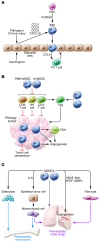Myeloid-derived suppressor cells in the tumor microenvironment: expect the unexpected
- PMID: 26168215
- PMCID: PMC4588239
- DOI: 10.1172/JCI80005
Myeloid-derived suppressor cells in the tumor microenvironment: expect the unexpected
Abstract
Our understanding of the role of myeloid-derived suppressor cells (MDSCs) in cancer is becoming increasingly complex. In addition to their eponymous role in suppressing immune responses, they directly support tumor growth, differentiation, and metastasis in a number of ways that are only now beginning to be appreciated. It is because of this increasingly complex role that these cells may become an important factor in the treatment of human cancer. In this Review, we discuss the most pertinent and controversial issues of MDSC biology and their role in promoting cancer progression and highlight how these cells may be used in the clinic, both as prognostic factors and as therapeutic targets.
Figures



Similar articles
-
Myeloid-Derived Suppressor Cells: Critical Cells Driving Immune Suppression in the Tumor Microenvironment.Adv Cancer Res. 2015;128:95-139. doi: 10.1016/bs.acr.2015.04.002. Epub 2015 May 12. Adv Cancer Res. 2015. PMID: 26216631 Free PMC article. Review.
-
Immunosuppressive cells and tumour microenvironment: focus on mesenchymal stem cells and myeloid derived suppressor cells.Histol Histopathol. 2011 Jul;26(7):941-51. doi: 10.14670/HH-26.941. Histol Histopathol. 2011. PMID: 21630223 Review.
-
MDSCs in cancer: Conceiving new prognostic and therapeutic targets.Biochim Biophys Acta. 2016 Jan;1865(1):35-48. doi: 10.1016/j.bbcan.2015.08.001. Epub 2015 Aug 6. Biochim Biophys Acta. 2016. PMID: 26255541 Review.
-
Myeloid regulatory cells in tumor spreading and metastasis.Immunobiology. 2015 Feb;220(2):236-42. doi: 10.1016/j.imbio.2014.07.017. Epub 2014 Jul 23. Immunobiology. 2015. PMID: 25178934 Review.
-
Molecular Pathways: Targeting Tumor-Infiltrating Myeloid-Derived Suppressor Cells for Cancer Therapy.Clin Cancer Res. 2015 Jul 15;21(14):3108-12. doi: 10.1158/1078-0432.CCR-14-2261. Epub 2015 May 12. Clin Cancer Res. 2015. PMID: 25967145 Review.
Cited by
-
Immunotherapy for advanced thyroid cancers - rationale, current advances and future strategies.Nat Rev Endocrinol. 2020 Nov;16(11):629-641. doi: 10.1038/s41574-020-0398-9. Epub 2020 Aug 24. Nat Rev Endocrinol. 2020. PMID: 32839578 Review.
-
Aptamers against mouse and human tumor-infiltrating myeloid cells as reagents for targeted chemotherapy.Sci Transl Med. 2020 Jun 17;12(548):eaav9760. doi: 10.1126/scitranslmed.aav9760. Sci Transl Med. 2020. PMID: 32554710 Free PMC article.
-
Mesothelioma response to carbon nanotubes is associated with an early and selective accumulation of immunosuppressive monocytic cells.Part Fibre Toxicol. 2016 Aug 23;13(1):46. doi: 10.1186/s12989-016-0158-0. Part Fibre Toxicol. 2016. PMID: 27549627 Free PMC article.
-
Small molecule inhibitors for cancer immunotherapy and associated biomarkers - the current status.Front Immunol. 2023 Oct 31;14:1297175. doi: 10.3389/fimmu.2023.1297175. eCollection 2023. Front Immunol. 2023. PMID: 38022587 Free PMC article. Review.
-
High monocytic MDSC signature predicts multi-drug resistance and cancer relapse in non-Hodgkin lymphoma patients treated with R-CHOP.Front Immunol. 2024 Jan 18;14:1303959. doi: 10.3389/fimmu.2023.1303959. eCollection 2023. Front Immunol. 2024. PMID: 38304256 Free PMC article.
References
-
- Dolcetti L, et al. Hierarchy of immunosuppressive strength among myeloid-derived suppressor cell subsets is determined by GM-CSF. Eur J Immunol. 2010;40(1):22–35. - PubMed
Publication types
MeSH terms
Grants and funding
LinkOut - more resources
Full Text Sources
Other Literature Sources

